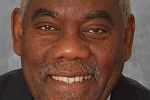By Dr Selwyn R. Cudjoe
August 02, 2025
PART II
 Ulric “Buggy” Haynes was not only a sports figure but a social activist as well. He led the charge to save the Tacarigua Savannah, the largest green space area in the northeastern part of the island, from becoming a concrete and asphalt jungle. The Green Space Committee raised almost $100,000 to challenge the government’s violation of our community’s well-being.
Ulric “Buggy” Haynes was not only a sports figure but a social activist as well. He led the charge to save the Tacarigua Savannah, the largest green space area in the northeastern part of the island, from becoming a concrete and asphalt jungle. The Green Space Committee raised almost $100,000 to challenge the government’s violation of our community’s well-being.
Buggy led the charge with Dr Carol James and Peter Burke to oppose the government’s action. He gave the first $20,000 to hire lawyers to fight the case, money that he borrowed from one of his sons, Verron Ulric Haynes, the first and only Trinbagonian to win a Super Bowl for the Pittsburgh Steelers.
Verron may have inherited his athletic skills from his father, but he also learned the art of “giving back to his community” from him.
He said: “When I joined the Pittsburgh Steelers, the first thing I asked was ‘who was in charge of the community service programme for the team’. I went down to the Boys and Girls Club of that city, introduced myself and told them that I will be the spokesman for their club. I teach my son that giving back is the most important thing in the world.”
That is the power of example. Verron learned from a father in “a sleepy village in Trinidad” what it meant to serve the children of the United States. Today his uncle Neal Philip, an environmental engineer, is the chairman of the Chemistry Department at the City University of New York.
He has three grants from the US State Department Public Diplomacy Grants to increase climate monitoring and awareness in eight states in India. He did similar work in Australia and Spain with his students.
This, perhaps, is an extraordinary example of the Philip/Haynes family following the example of Buggy and his grandfather which culminated in serving the world.
Buggy was also a member of the Tacarigua Welfare and Improvement Council (later called the Tacarigua Village Council) which started in 1946. His mother was a vibrant member of the Village Council. Today, there is a sparkling community centre that the People’s National Movement government built on the land that the Trinidad Sugar Estates rented to Joseph Waterman, the grandfather of Ulric “Buggy” Haynes.
Ulric “Buggy” Haynes represented the essence of what it means to be an active member of a community. He also personified the spirit of social engagement upon which any community should locate itself.
His commitment to his village was no passing thing. It was part and parcel of his social make-up that gave him the strength to carry on even through his illness.
We must honour this black prince by doing three things he wanted to do in his life which Bane Alexis, another districker, has worked so hard to fulfil:
(a) We must demand of the Government—and I will try to lead that endeavour—that the Holy Ground, the Eddie Hart Savannah, the Dinsley and Ulric Haynes ground—the whole of the savannah be declared a historical site by law. If we achieve this, no power-hungry individual can do what s/he wants to do with our savannah.
(b) We should design and build a bronze statue of Buggy and place it at the head of the Buggy Haynes Ground to honour the contributions he made to our community. We should always remember Buggy driving his cub cadet seeded lawn mower, mowing the savannah as though it was his baby.
(c) We should create a committee of about five members from the Tunapuna/Piarco corporation and five members from the community to run and control the Tacarigua savannah so that no one can come from wherever he comes from and tell us how we should run and control our sacred space.
Buggy Haynes was a great man. He cared for us, as I hope we will continue to care about him.
And so I end as I began, with the words of Ossie Davis:
“However we may have differed with him, or with each other about him and his value as a man, let his going from us serve only to bring us together.
“Consigning these mortal remains to earth, the common mother of all, secure in the knowledge that what we place in the ground is no more now a man, but a seed, which, after the winter of our discontent, will come forth again to meet us.
“And we will know him then for what he was and is, a prince—our own black-skinned prince!—who didn’t hesitate to die, because he loved us so.”
As we consign Ulric “Buggy” Haynes to the ground, let us take hope and consolation from the fact that God is love and, through him, we must seek to always love one another.
—Prof Cudjoe’s e-mail address is srcudjoe1@gmail.com He can be reached @ProfessorCudjoe.
